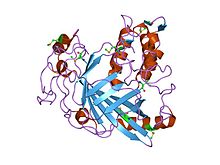
Back لوسيفراز Arabic Луцифераза Bulgarian Luciferasa Catalan Luciferáza Czech Luciferasen German Luciferazo Esperanto Luciferasa Spanish Lutsiferaas Estonian Luziferasa Basque لوسیفراز Persian
| Bacterial Luciferase monooxygenase family | |||||||||||
|---|---|---|---|---|---|---|---|---|---|---|---|
| Identifiers | |||||||||||
| Symbol | Bac_luciferase | ||||||||||
| Pfam | PF00296 | ||||||||||
| InterPro | IPR016048 | ||||||||||
| PROSITE | PDOC00397 | ||||||||||
| SCOP2 | 1nfp / SCOPe / SUPFAM | ||||||||||
| |||||||||||
| Dinoflagellate Luciferase catalytic domain | |||||||||
|---|---|---|---|---|---|---|---|---|---|
 crystal structure of a luciferase domain from the dinoflagellate Lingulodinium polyedrum | |||||||||
| Identifiers | |||||||||
| Symbol | Luciferase_cat | ||||||||
| Pfam | PF10285 | ||||||||
| InterPro | IPR018804 | ||||||||
| |||||||||
| Dinoflagellate Luciferase/LBP N-terminal domain | |||||||||
|---|---|---|---|---|---|---|---|---|---|
| Identifiers | |||||||||
| Symbol | Luciferase_N | ||||||||
| Pfam | PF05295 | ||||||||
| InterPro | IPR007959 | ||||||||
| |||||||||
| Dinoflagellate Luciferase helical bundle domain | |||||||||
|---|---|---|---|---|---|---|---|---|---|
| Identifiers | |||||||||
| Symbol | Luciferase_3H | ||||||||
| Pfam | PF10284 | ||||||||
| InterPro | IPR018475 | ||||||||
| |||||||||
Luciferase is a generic term for the class of oxidative enzymes that produce bioluminescence, and is usually distinguished from a photoprotein. The name was first used by Raphaël Dubois who invented the words luciferin and luciferase, for the substrate and enzyme, respectively.[1] Both words are derived from the Latin word lucifer, meaning "lightbearer", which in turn is derived from the Latin words for "light" (lux) and "to bring or carry" (ferre).[2]
| Firefly luciferase | |||||||
|---|---|---|---|---|---|---|---|
 Structure of Photinus pyralis firefly luciferase. | |||||||
| Identifiers | |||||||
| Organism | |||||||
| Symbol | Firefly luciferase | ||||||
| PDB | 1LCI More structures | ||||||
| UniProt | P08659 | ||||||
| Other data | |||||||
| EC number | 1.13.12.7 | ||||||
| |||||||
Luciferases are widely used in biotechnology, for bioluminescence imaging[3] microscopy and as reporter genes, for many of the same applications as fluorescent proteins. However, unlike fluorescent proteins, luciferases do not require an external light source, but do require addition of luciferin, the consumable substrate.
- ^ Lee J (28 February 2014). "A History of Bioluminescence". photobiology.info. Archived from the original on 29 March 2015.
- ^ Lee J (September 2008). "Bioluminescence: the First 3000 Years (Review)". Journal of Siberian Federal University. Biology. 1 (3): 194–205. doi:10.17516/1997-1389-0264.
- ^ Brennan CK, Ornelas MY, Yao ZW, Prescher JA (August 2021). "Multicomponent Bioluminescence Imaging with Naphthylamino Luciferins". ChemBioChem. 22 (16): 2650–2654. doi:10.1002/cbic.202100202. PMC 8496354. PMID 34139065.